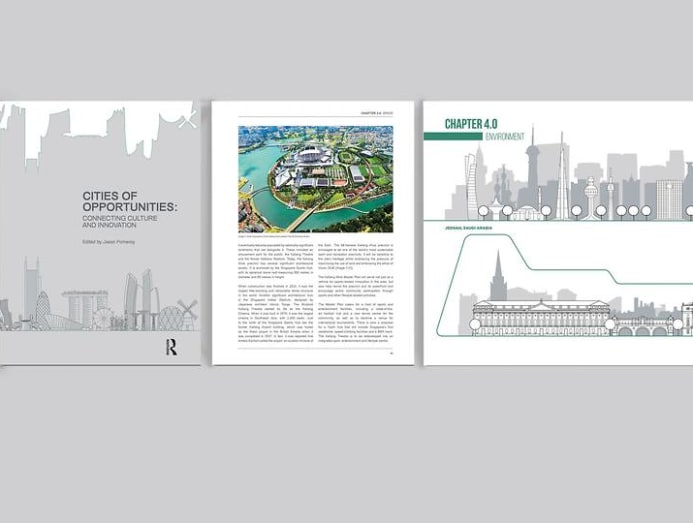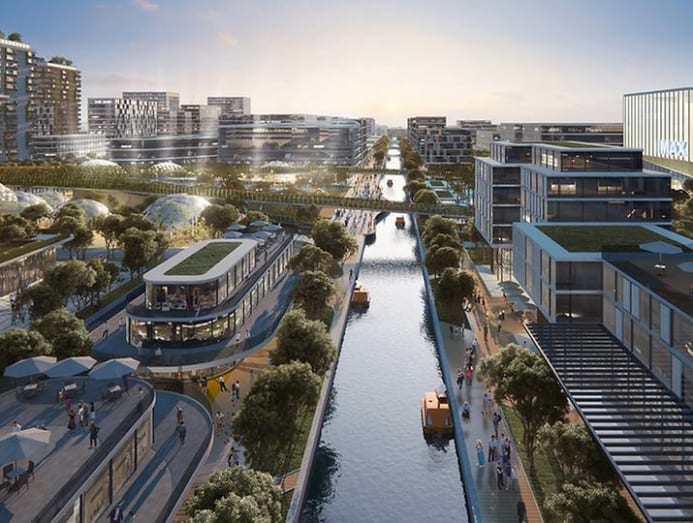How can Singapore be a more liveable city with happy, healthy citizens?
Jason Pomeroy is a busy man. He not only designs green buildings and masterplans through his eponymous studio, but the confident, articulate and dapper dresser has also researched and presented multiple design-focused tv set series for CNA, such as City Time Traveller.
He also founded the Pomeroy University to preach the green gospel to administrators, 3rd students and even young school children, penned books on the sustainable tropical firm, high-density greening and free energy efficient floating pods, and lectures at universities.
It's a miracle that Pomeroy can detect time for annihilation else, but the multi-hyphenate has gone on to write a quaternary volume. The championship Cities of Opportunities: Connecting Culture and Innovation corresponds with that of the Un' tenth Earth Urban Forum held in Abu Dhabi in February this year.

READ> The architects designing the Punggol Digital Commune on creating a greener Singapore
The progressive think tank gathers policy makers, academics and designers to dialogue on sustainable urbanism, in the hope of furthering collaboration between individual and public entities for the greater good.
This yr'due south theme of cultural sustainability builds upon a case that Pomeroy has long championed.
He believes that the current one-size-fits-all approach to sustainability, space planning and technological integration does not accurately meet the needs of increasingly multi-cultural and heterogeneous urban centres. With population in cities projected to exceed nine billion people by 2050, the debate on shaping smart cities need to go deeper.
Civilisation is one of Pomeroy's six pillars of sustainable thinking. The others are infinite, society, surround, economy and applied science. Their coming together enables more holistic solutions, and has served as foundational frameworks for Pomeroy'due south designs ranging from carbon-negative houses to macro-scale projects such equally the 89-hectare Kallang Live Chief Plan.

READ> Singapore Archifest 2020: Can compages save the world?
They besides make up the chapters of the book, which sees 12 academics and practitioners from across the world, including him, contributing their thoughts on what civilization and innovation hateful to them in their ain disciplines.
"What I wanted to do was motion beyond the obvious, considering people think of civilization only as something existence locked in fourth dimension, and innovation equally skewed toward the future. But civilization and innovation are inter-related," said Pomeroy.
He highlights Professor Hisham Mortada's essay that links man'southward stewardship of nature established in the Qur'an to passive environmental design strategies of some ancient Westward Asian structures.
"I found that fascinating because you don't assume a book of that spiritual nature, which originated many years ago, necessarily having much reference to today's built surround," said Pomeroy.
Preserving and utilising natural resources, and giving residents equal rights to make clean water, air and light are principles discussed in the chapter that are every bit germane today.
"People think of culture only equally something being locked in time, and innovation as skewed toward the future. But civilisation and innovation are inter-related." – Jason Pomeroy
Similarly, CEO of Sports Sg and ex-national h2o polo player Lim Teck Yin's showcase of the symbiotic human relationship between egalitarian sports facilities and a potent sports culture in Singapore results in a more liveable urban center and happy, healthy citizens.
Pomeroy contributes the last chapter, where he argues for a balanced arroyo to the utilize of technology for cities transiting from manufacturing-based to digital-based economies.
The case of Songdo in Korea – a technologically avant-garde city built from scratch – is impressive but lacks citizen participation; in contrast, the Indonesian metropolis of Bandung employs social media every bit a conduit for citizens to feedback on crime, accidents and service breakdowns to the government, resulting in quick and targeted responses, and ultimately more trust in the decision makers.
Without a doubt, Pomeroy's cross-cultural heritage and well-exposed childhood has created a global citizen attuned to broader viewpoints. The United kingdom-born child of a British begetter and Malaysian-Chinese mother spent weekends in museums, the odd yearly holiday in another European city or coast, and summer months in Malaysia, peculiarly the cities of Taiping, Penang and Kuala Lumpur.
Pre-COVID-nineteen, Pomeroy travelled well-nigh weekly for work and academic engagements, relishing in the invigorated commutation of cognition they bring. Being stuck at home for such a long period during the Circuit Breaker left him restless enough to embark on culinary experiments in the same studious way as he does enquiry.
"That resulted in many a salmagundi being tested on unsuspecting guests. No medical attention was required and they have returned for other 18th-century inspired feasts," quipped the self-declared life learner, who boasts degrees from Canterbury School of Architecture, the University of Cambridge and the University of Westminster.

On a more serious note, Pomeroy has had ample fourth dimension to retrieve about how the pandemic warrants new ways of pattern that should exist as socio-culturally weighted every bit they are spatially engaged. And it can but be achieved when the right groups come up together in the aforementioned mind.
A medical analogy makes his case. He narrates how Oxford University's collaboration with pharmaceutical corporation AstraZeneca in the search for a COVID-19 vaccine made quick progress due to smoothen clinical trials arranged past an agile authorities.
"Arguably, this model that sees the collaboration of academia, government, ceremonious society and private corporation demand not exist reserved for the cosmos of a [COVID-19] vaccine, but should simply exist a model for the creation of more resilient and sustainable congenital environments."
"Arguably, this model that sees the collaboration of academia, government, ceremonious order and private corporation need not be reserved for the creation of a [COVID-nineteen] vaccine, but should simply exist a model for the creation of more resilient and sustainable built environments."
READ> The architects out to save the world through sustainable design
Source: https://cnalifestyle.channelnewsasia.com/people/how-can-singapore-be-a-more-liveable-city-247296
0 Response to "How can Singapore be a more liveable city with happy, healthy citizens?"
Post a Comment